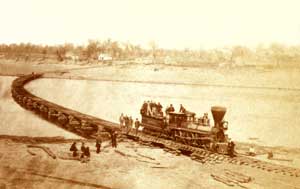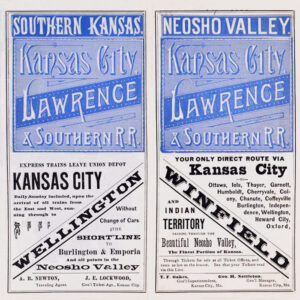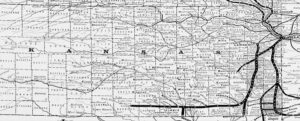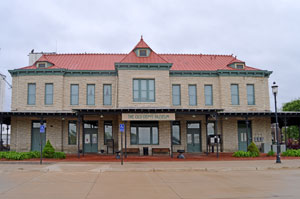Initially, the Kansas City, Lawrence, and Southern Kansas Railroad went by several other names.
In 1858, a group of businessmen from Lawrence, Kansas, advocated a railroad route to the Gulf of Mexico. The Leavenworth, Lawrence & Fort Gibson Railroad Company was chartered by a Kansas Territorial Legislature Act on February 12, 1858, to connect Lawrence with the Neosho River to the south. However, the Civil War delayed their plans.
The charter was amended by another act of the State Legislature and approved on February 29, 1864. This act authorized the company to build a railroad from Leavenworth to the southern border of Kansas.
Senator James Lane was the first president of the Leavenworth, Lawrence & Fort Gibson Railroad. In 1865, he promoted the line to communities along the route to vote for construction bonds. However, construction on the line did not begin until its name was changed to the Leavenworth, Lawrence & Galveston Railroad on February 24, 1866. The management changed with Senator Lane’s suicide on July 11, 1866.
By the end of 1867, the Leavenworth, Lawrence & Galveston Railroad completed its line between Lawrence and Ottawa, although regular service did not begin until early January 1868. However, the company struggled to find financial support and strong leadership. Under the direction of James Joy, the railroad was completed to the Kansas state line at Coffeyville via Humboldt, a distance of 144 miles, on September 3, 1871.

Leavenworth, Lawrence & Galveston Railroad Bridge across the Kansas River, Lawrence, Kansas, by Alexander Gardner, 1867.
On March 5, 1875, the Leavenworth, Lawrence & Galveston Railroad Company entered receivership and was sold at foreclosure. Struggling to survive, the railroad was sold on October 22, 1878. Under the reorganization, the Leavenworth, Lawrence, and Galveston Railroad became the Lawrence and Galveston Railroad on March 5, 1879. On March 29, 1879, the companies operated by the Leavenworth, Lawrence & Galveston Railroad—the Southern Kansas and the Kansas City and Santa Fe —were consolidated with the Lawrence and Galveston Railroad. The result was called the Kansas City, Lawrence, and Southern Railroad.
The quickly growing Atchison, Topeka & Santa Fe Railroad took control of the stock in November of 1880. Still, it ran it under the name of the Kansas City, Lawrence, and Southern Railroad Company.
In December 1880, the Kansas City, Lawrence & Southern Kansas Railroad, the Ottawa & Burlington Railroad, and the Kansas City & Olathe Railroad Companies were consolidated under the name of the Southern Kansas Railroad Company.
During the 1880s, the highest speed allowed for express passenger trains was 25-35 miles per hour. The highest speed allowed for mail and freight trains was 15 miles per hour.
The Division Headquarters of the Kansas City, Lawrence, and Southern Kansas Railway Depot was built in 1888 in Ottawa, Kansas. The Santa Fe Railroad relocated to a new depot in 1962, donating it to the Franklin County Historical Society. The museum opened to the public on July 4, 1963, and is located at 135 West Tecumseh Street in Ottawa.
From May 1, 1882, until the mid-1970s, the line operated as the Atchison, Topeka & Santa Fe Railroad. This company operated the line until the mid-1970s. In 1990, they sold to the Kansas City Terminal Railway Company, which filed for abandonment that year.
A section of the original route between Lawrence and Baldwin City (known then as the Lawrence District) was abandoned in 1963. The remainder between Baldwin City, Kansas, and Tulsa, Oklahoma, survived under Santa Fe ownership until 1990 when the railroad elected to sell much of the corridor. Most of the route was preserved and purchased by various entities to maintain rail service and is still in operation today.
©Kathy Alexander/Legends of Kansas, updated December 2025.
Also See:
Railroads & Depot Photo Gallery
Sources:
Abandoned Rails
Kansas State Historical Society
Ghosts of Wall Street
Santa Fe Resources
Trail Link



